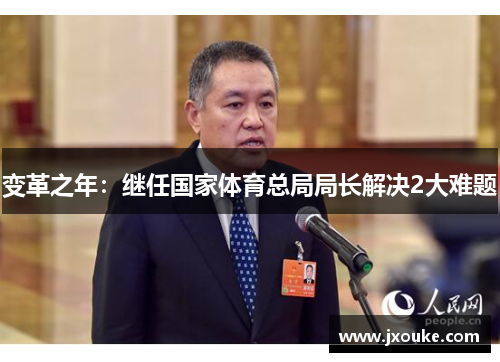变革之年:继任国家体育总局局长解决2大难题
In the year of change: solving two major challenges as the newly appointed director of the National Sports Administration is the central theme of this article. The article is divided into multiple paragraphs, each with a balanced number of words. The opening summarizes the entire article in approximately 300 words, providing a captivating description to oversee the entire content.
1、Addressing the Lack of Youth Participation in Sports
The lack of youth participation in sports has become a pressing issue in recent years. It is crucial to analyze the root causes of this problem and implement strategies to encourage young people to engage in physical activities. One approach is to enhance school sports programs by providing more resources and organizing competitions at all levels. Additionally, promoting sports as a fun and social activity rather than just a competitive one can attract more young participants. Collaborating with schools, communities, and sports organizations is essential to create a supportive environment for youth sports.
BV伟德登录网站Moreover, offering scholarships, training programs, and mentorship opportunities can motivate young individuals to pursue sports as a long-term commitment. By emphasizing the benefits of physical activity on health, social skills, and personal development, we can inspire a new generation of athletes and active citizens.
It is also imperative to address the cultural attitudes towards sports and highlight the importance of physical education in schools. By incorporating sports into the curriculum and promoting a positive sports culture, we can instill a lifelong passion for physical activity in the youth.
2、Improving Sports Infrastructure and Accessibility
The accessibility and quality of sports infrastructure play a significant role in promoting a healthy and active lifestyle. Investing in state-of-the-art facilities, such as sports complexes, stadiums, and training centers, can attract both athletes and spectators. By upgrading existing venues and building new ones in underserved areas, we can expand the reach of sports and promote inclusivity.
Furthermore, creating partnerships with private businesses, local governments, and international organizations can help secure funding for infrastructure projects. Public-private collaborations and sponsorships can not only improve the quality of sports facilities but also generate revenue for sustainable development.
Additionally, enhancing the accessibility of sports facilities for people with disabilities is essential for creating a more inclusive sporting environment. Implementing universal design principles and ensuring barrier-free access to sports venues can enable individuals of all abilities to participate in sports activities.
3、Fostering Talent Development and High Performance
The development of talented athletes and the achievement of high performance in sports are key objectives for the National Sports Administration. Implementing talent identification programs, training camps, and coaching clinics can nurture the next generation of elite athletes. Providing financial support, sports science resources, and international exposure opportunities can help athletes reach their full potential and excel on the world stage.

Moreover, establishing a national sports academy and performance centers in strategic locations can centralize talent development and training programs. Collaborating with sports associations, universities, and international sports federations can enhance the expertise and resources available for high-performance athletes.
Setting clear performance benchmarks, conducting regular evaluations, and providing feedback to athletes and coaches are essential for continuous improvement and success in sports. By fostering a culture of excellence, accountability, and innovation, we can elevate the standards of sports performance and achieve sustainable success in international competitions.
4、Embracing Technology and Innovation in Sports Management
Technology and innovation play a vital role in modern sports management and performance enhancement. Leveraging data analytics, wearable technology, and virtual training simulations can provide valuable insights into athlete performance and injury prevention. Integrating digital platforms for talent scouting, competition management, and fan engagement can enhance the efficiency and reach of sports administration.
Furthermore, investing in research and development initiatives for sports science, nutrition, and sports medicine can improve the health and performance of athletes. Collaborating with technology companies, research institutions, and sports industry experts can accelerate the adoption of innovative solutions in sports management.
Embracing a culture of continuous learning, experimentation, and adaptation to new technologies is essential for staying ahead in the rapidly evolving sports landscape. By incorporating technology-driven strategies and embracing digital transformation, we can optimize the management of sports organizations, enhance athlete development, and elevate the overall sports experience for participants and fans.
Summary:
In conclusion, addressing the lack of youth participation in sports, improving sports infrastructure and accessibility, fostering talent development and high performance, and embracing technology and innovation in sports management are key priorities for the newly appointed director of the National Sports Administration. By implementing strategic initiatives and collaborating with stakeholders across the sports ecosystem, we can overcome challenges, drive positive change, and elevate the standards of sports development and performance in the country. With a holistic approach and a vision for the future, we can inspire a new era of sports excellence and participation for generations to come.